When Kirk and I were looking at where to visit in Greece outside of Athens, initially, our minds went to the Greek islands. Facebook is always full of beautiful photos of islands like Santorini, with it’s infamous white city on a hill and beaches with clear turquoise waters. However, in looking at what worked best with our budget, our interests, and our timeline, Kirk came up with the idea of instead visiting the Greek Peloponnese, and y’all, it did not disappoint.
If you’ve never been to this area of Greece, you might be wondering, what exactly is the Greek Peloponnese? In short, it’s land of myth and legend, scattered with ruins, vineyards, mountains, and gorgeous turquoise beaches. It’s the home of Ancient Olympia (where the olympics began), Sparta (think, the movie “300”), Kalamata (as in, famous olives), as well as Corinth (as in, 1 and 2 Corinthians). There is so much to see and do on the Peloponnese that we didn’t come close to viewing the whole thing, but the areas we did see were breathtaking.
We rented a car and ultimately broke our time on the Peloponnese down into three different cities that we slept in, using those locations and home base while venturing out to other places during the days and in between cities. Our first city was Kalamata, then Ancient Olympia, and finally, Corinth.
Our first day on the road, we traveled from Athens to Kalamata, stopping at Sparta on the way. Unfortunately, for the first half of this drive, we were unaware of the insane amount of toll booths one encounters while driving in Greece. In our first two hours of driving, we hit a tollbooth approximately every 15 minutes. By the time we made it to Sparta, we’d nearly spent our budget for the day! As we’d later learn, these new toll roads have been built for a reason, but y’all, just know – driving in Greece gets expensive when you take the nice roads!

Somewhere just outside Sparta. It was lovely!
Once we arrived in Sparta, we headed straight for the ancient ruins. It took some maneuvering to get there, but upon arrival we found that there were no fees for visiting, and the grounds had no one there keeping watch – a rare thing from what we’d encountered in Athens! We wandered around in peace imagining what it must have been like to live in this ancient city that was known for it’s military strength. Much like the movie “300” portrays, in ancient Sparta, everything within the city state was aimed at developing their military. Babies born that seemed weak in any way were discarded at birth. At the age of 7, boys who were full citizens were taken from their families to begin being trained for battle. Slaves and second class citizens kept work going outside of military trainings to ensure the city continued running while the “full citizen” men trained for battles. Women were seen as strong and had a voice at the table (even in military endeavors), which was quite uncommon compared to other city states around them in that time. Though the movie “300” took some liberties in how it portrayed Sparta and Spartans, it’s based on a true story, and it was pretty crazy to walk around this ancient city imagining what it was like to live there in that time.

Kirk, walking around what’s left of the city
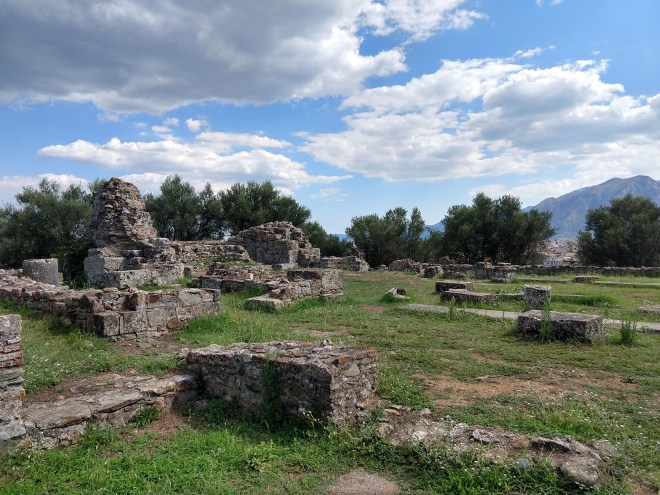
The ancient ruins of Sparta sit high on a hill in modern Sparta. Behind the ruins and olive trees, a glance of modern city and mountains peeks through. It’s quite a beautiful area.
On the far side of Ancient Sparta (at least the far side from the modern day entrance gate) an old theater is built at the bottom of the hill. Old writings tell us that Sparta had a theater as early as 5th century BC, but the ruins seen below likely date to around 30-20 BC. This theater was once capable of holding up to 17,000 people. Where grass now greets us at the top of the hill, seats would have once layered all the way up to this edge of the city center.

Behind the theater, a grove of olives trees creates a dividing line between the old and new city. Also – those mountains ❤️. In person, this was a breathtaking view!
After getting a glimpse of Sparta, we got back on the road to head towards Kalamata. Trying to learn from our first mistake, we set our GPS to avoid tolls, but in doing so, we had no idea what was in store – Curves and potholes, single lane mountain roads, and large missing pieces of asphalt that had apparently gone down in a landslide. I’ve never been so thankful for Kirk’s driving skills – or for such a crazy experience. In the midst of some of the terror, there was immense beauty. With every inch we gained in altitude, the view only got better. In our previous journey on the toll road, the experience was more like an interstate – whizzing by all the beauty around us. Here, on the mountain, we were forced to take things slowly, and though parts of it had us fearing for our lives, we were so overtaken with beauty that we also chose to take these roads for the rest of our trip around the Peloponnese.
Below is a video of some tunnels we went through near the top of a mountain. Prior to pulling out the camera we passed under a “tunnel” that only covered the top and right side of us. It looked as if it was carved out that way from the start, but it felt bizarre to drive under such a large rock without support on the left! Imagine the tunnel in the video below without a left side, keeping in mind that to the left is a sharp drop into the valley below (and ignore the dirty windshield 😂).
Mountain roads
The little towns built into the side of the mountain all looked like something from a movie scene. Below is a picture of a small church we saw perched high on a hill, overlooking the rest of the mountain town.

Mountain towns
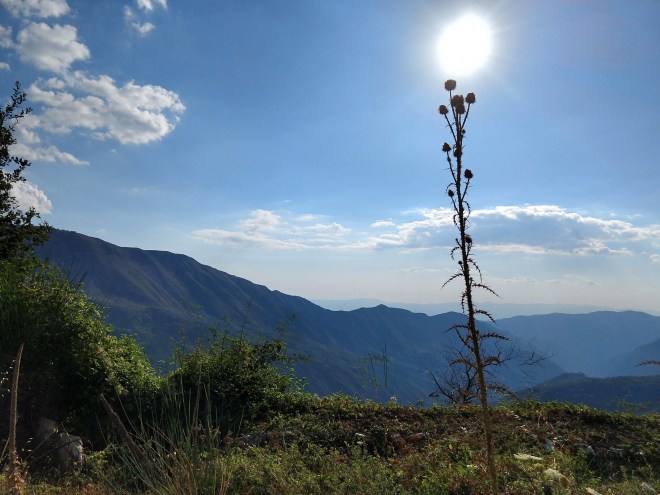
Mountain views

Check out the color in cliff! There was so much beauty to be seen.
Not long after we started up the mountain road, we began to see loaded wild blackberry bushes all along the side of the road. We passed them for kilometers on end before deciding it was time to stop and eat some. It took some time to find a place on the road that we felt safe stoping, but eventually we came to a section with a small shoulder and we pulled over. We went in for a taste and looked at each other in surprise. In Texas, these wild blackberries usually have a tartness to them, but here in these mountains, there was no tartness to be found – they almost tasted more like blueberries. In the end, we didn’t just eat some, we loaded up, filling a small brown bag that once held a bell pepper from the grocery store. Over our next several days on the road, we always kept our eye open for safe places to pause and pick more. They were too tasty to resist!

Picking wild blackberries on the mountain’s shoulder.
After many ups and downs, we eventually made it to our final destination, a place we found on airbnb called “Art Farm.” Art Farm is located just outside Kalamata, up on a mountain the overlooks the city and the sea. The views from this place were gorgeous and the family that owns it are an exact image of a boisterous Greek family portrayed in film – warm and welcoming, with big smiles and gestures. They grow most of their food on the farm and spend the evening laughing and preparing meals together. Though the “kids” are now grown, they all help with the family business. There is a kinship between the whole family that draws you in and makes you feel apart of the family too. On their land they’ve built many rooms as well as a small amphitheater where they sometimes host shows. It’s a lovely little place! 
View of the sunset one night from the top of the amphitheater on the farm.
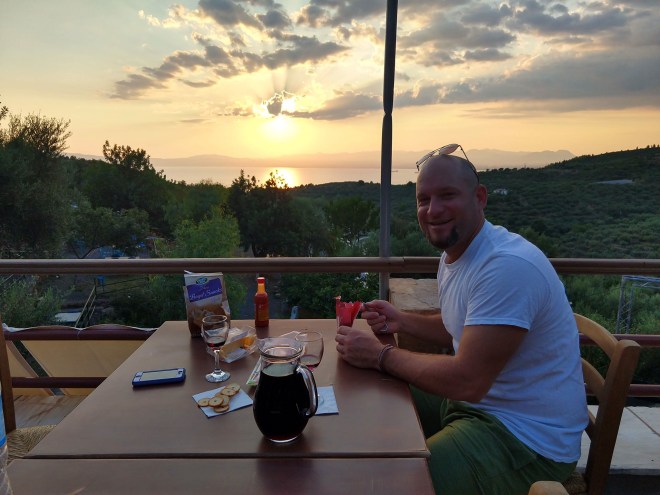
Crackers, cheese, and wine while watching the sunset from the terrace on a different night.
Our single full day in Kalamata we ventured down to the seaside and were greeted by the most beautiful stone beach. The waters were turquoise and clear and tons of people were there to enjoy it. We were able sit on chairs with umbrellas with no obligation to buy anything, even though they belonged to a restaurant. We were even more surprised when we asked for a menu anyway and found that the prices were the same as any ole restaurant down the street. We got a salad, sandwich, and fries for around $11 euros. Not bad for a lunch on the beach!
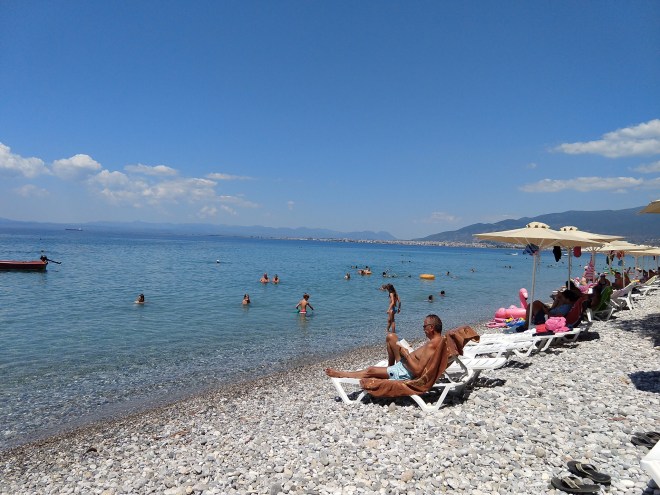
The clear waters

I was getting a picture of the inflatable donut in the ocean, but the woman doing a handstand makes for a pretty fun picture too 🙂

Lunchtime! Greek salads are one of my new favorites! No lettuce on them, but the huge slab of feta on top does not disappoint!
While we ate our lunch we noticed that all the people around us were ordering similar looking drinks. We asked what it was and immediately recognized the name from a list of “must tries in Greece” we’d seen online. We got one ourselves and it was so good that I looked up recipes as soon as we got home that night 😂. Below – Freddo Cappuccino.

Freddo Cappuccino – this tasty treat is cold frothed espresso and milk. Somehow, they don’t use a steamer to make the foam, but rather, one of those machines we use at home to make old timey milkshakes. The foam is extra thick and delicious. It can be ordered sweet or unsweetened, or black, with coffee foam and no milk.
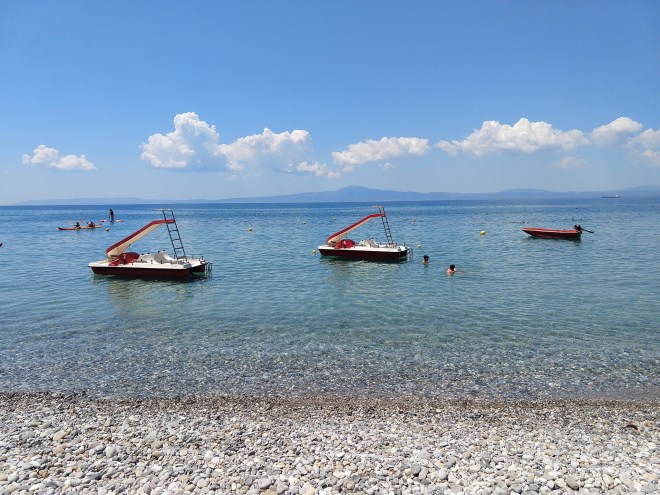
These fun paddle boats were available to rent. They have a water slide attached!
The next day, as we packed up to leave Kalamata, our hosts informed us about a beautiful waterfall that we’d pass on our way to our next to destination. We, of course, stopped. It turned out to be a sort of long waterfall – at the bottom were small falls, and as you followed them quite a ways up, you eventually came to the larger fall that had a swimming hole at the bottom. The colors of the pools of water were eerily beautiful.

The first small falls

A better idea of the color the water looked in the pools

Polylimnio Waterfall – The biggest of the falls with the swimming hole below. The water was so clear!
After our short pause at the falls, we headed to our second stopping point for the day, Voidokilia beach. This famous semi-circle beach with crystal clear waters and small cliffs around it is located in a protected area. Everyone brings their own towels, chairs, food, and umbrellas because businesses aren’t allowed to move onto it. Even with the many visitors, something about the lack of commercialism makes it a really peaceful place to visit. In the right sunlight, the waters light up in all shades of turquoise, aquas, blues, and greens. Look it up online for some pics from better cameras in different sunlight – it’s gorgeous!

A panorama from a hill next to the beach.
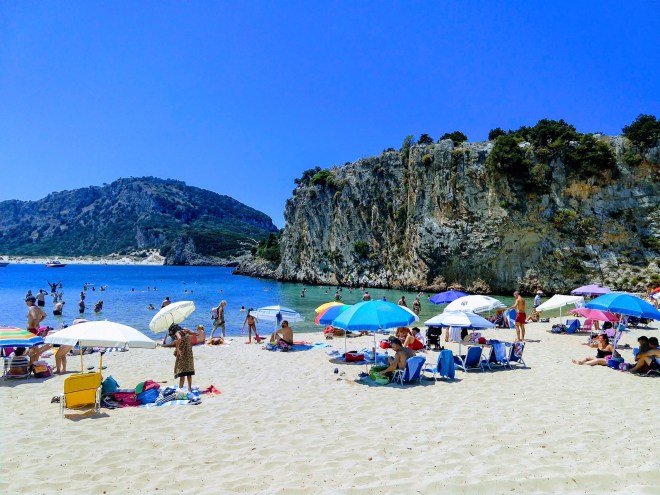
One of our photos that google photos “stylized” for us. These colors are more what it looked like to my eyes!
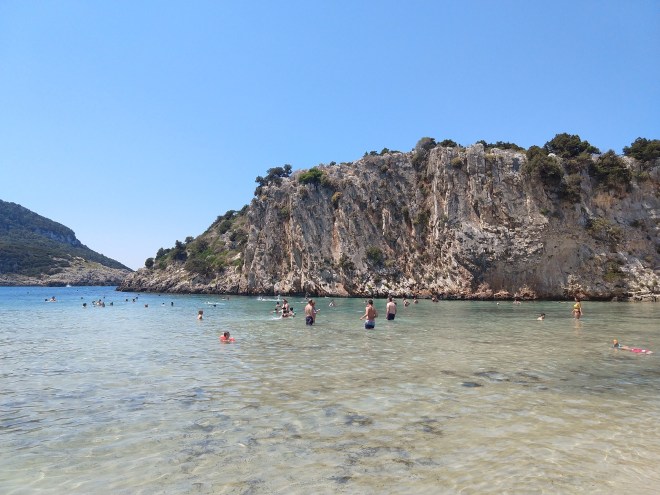
Look how clear that water is! It’s shallow for a very long way out.
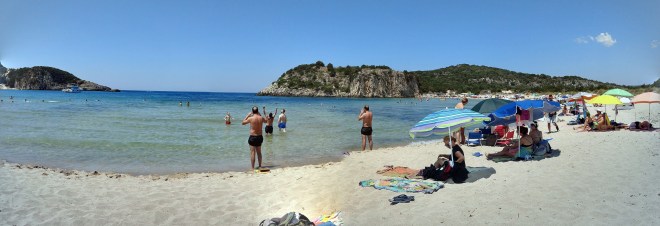
A view of where the water flows in between the cliffs from the larger ocean to form this beach.
We hung out at the beach for a few hours before getting back on the road again, our ultimate destination for the day being Olympia.
A second place our hosts in Kalamata told us about was a town nearby called Filiatra with an Eiffel Tower of its own. As the story goes, a man from this mountain village visited Paris, France and loved the Eiffel Tower so much that he went home and built one of his own in his field. It sat in his field for sometime before the city decided that it too loved his statue, and offered to buy it from him. It now sits in the city center, and though we had no intention of going out of our way to visit it, we ended up passing it on the main road through town and had to snap a picture. At 26 meters tall, it’s certainly not small!
Can you imagine driving around in the mountains and happening upon someone building this in their field? That’s a fantastic image!

Eiffel Tower in the Greek Peloponnese
After plenty more mountain driving, we arrived in Olympia that evening and spent the next day exploring Ancient Olympia.
If you aren’t aware, Ancient Olympia is a pan-Hellenic site where the many separate Greek city states came to compete in the Olympics. Though it’s different than Mount Olympus (elsewhere in Greece) that was believed to be home to the gods, Ancient Olympia is an area dedicated to Zeus that was once the home to THE Temple of Zeus. Yes, THE temple of Zeus that was named in ancient writings as one of the original 7 wonders of the (ancient) world. (Side note, only one of these original 7 wonders still exists, the pyramids at Giza). In it’s prime, the Temple of Zeus was an enormous building that was home to an ivory and gold sitting statue of Zeus that was 43 feet high – and let me emphasize, he was sitting. Imagine how big he would have been standing! The statue was estimated to be finished around 435 BC. Though only scattered pieces of the temple remain (and the statue is gone entirely), visiting today you can still get an idea of the grandeur that once was.
In all, this area of Ancient Olympia was home to around 70 other temples, as well as the stadium of the first (several hundred) Olympic Games. It’s a large area that now also has a museum on it that houses some of the more “delicate” items (like, statues that they didn’t want out in the weather anymore), so it takes some time to explore.
We went to the museums first, so I’ll start with some pictures from those.
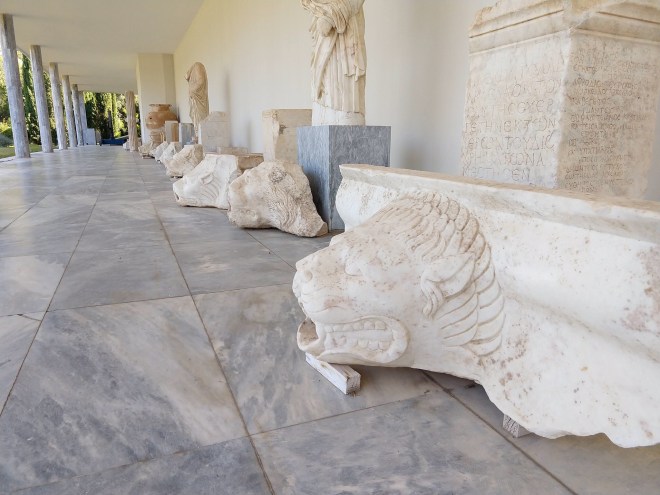
Lion head water spouts that once shed water off the top of the Temple of Zeus.
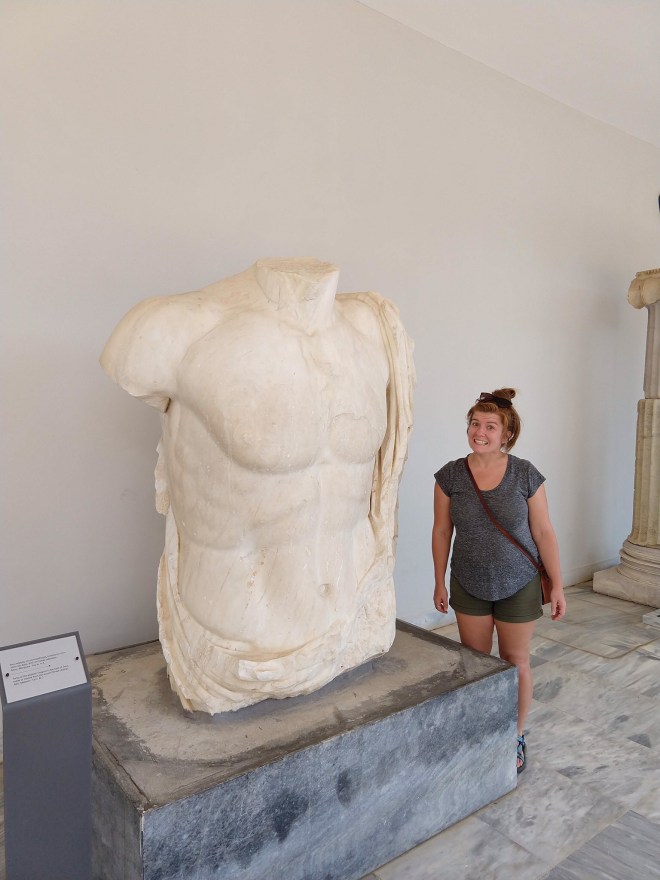
What’s left of the torso of Emperor August made from marble in 1st century BC. I stood next to it to show how big it was!
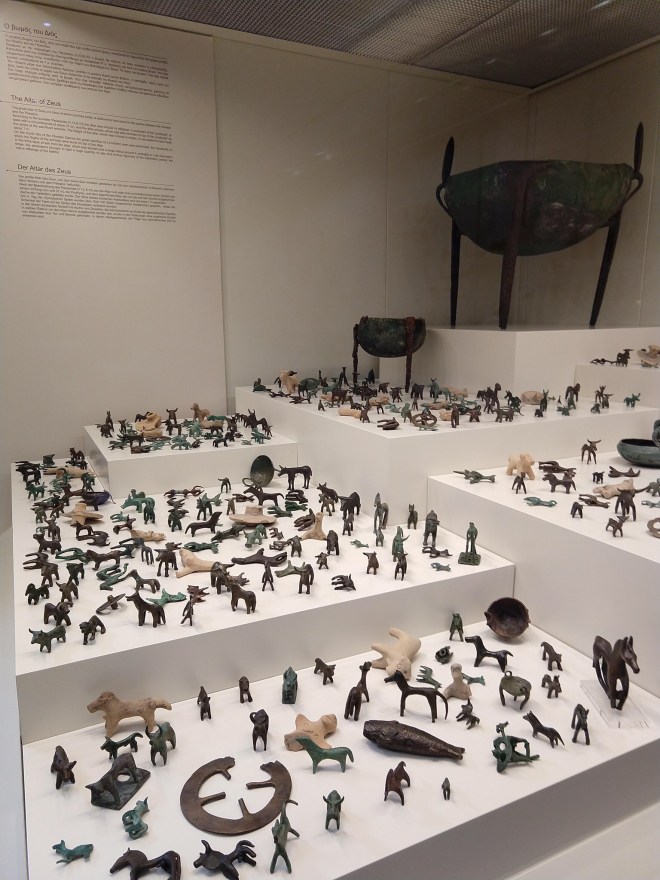
Offerings found next to where the Altar of Zeus once stood.
According to the sign next to these figurines, in the original Olympic Games, on the fourth day of the ceremonies, a sacrifice of 100 oxen was made to Zeus. The thighs of those oxen were burned on the altar of Zeus (which was enormous), and though no trace of the altar has been found, excavators have found ash from the altar all around where the altar once stood. Hundreds of the above figurines were found mixed in the ash from the altar. They are mini sacrifices of the people.

Bronze Corinthian Helmets.
Above is a variety of Corinthian helmets used over the years. Though this type of helmet design began in Corinth, this style spread throughout Greece.
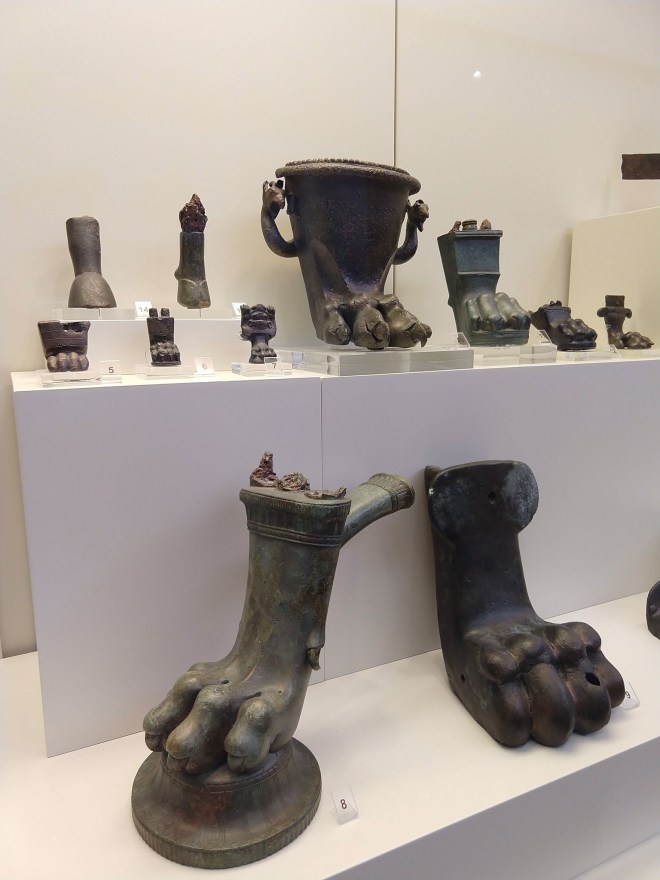
Bronze feet
These aren’t particularly important, I just loved the look of them – especially the pot with the foot on the bottom!

“Grave gifts” – Glass vases excavated from Miraka Cemetery that date back from 1st-4th century AD. Or in other words, if this glass is 1500-1900 years old, how long does it take glass to break down? 😬 That’s a crazy thought!

Old chariot wheel
Perhaps my favorite display in the museum is the room with the pediments of the Temple of Zeus. These larger than life statue displays once adorned the east and west side peaks of the roof of the Temple of Zeus. Each tells a story, and I can’t imagine how long it took to carve such intricate details (much less, place them so high!)
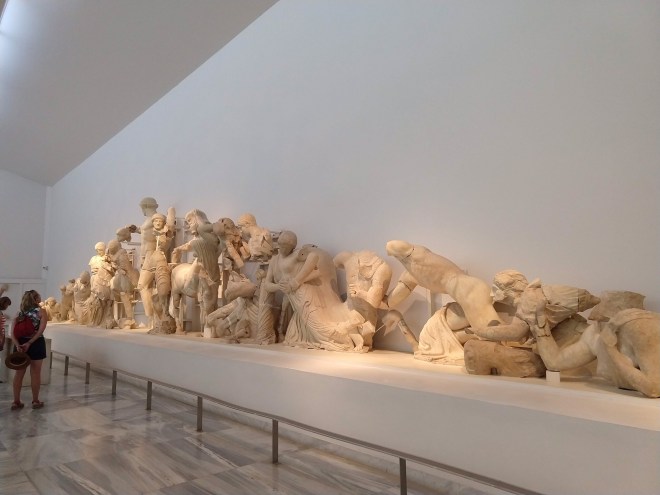
The West pediment – the battle of Lapiths and the Centaurs.
The story goes that the centaurs were invited to the wedding celebration of the King of Lapiths, but ended up causing a big scene by getting drunk and trying to steal women from the kingdom. It started a war, which Lapiths won. The scene above depicts the fighting breaking out at the wedding, the calm god, Apollo, at the center of it all, trying to maintain order.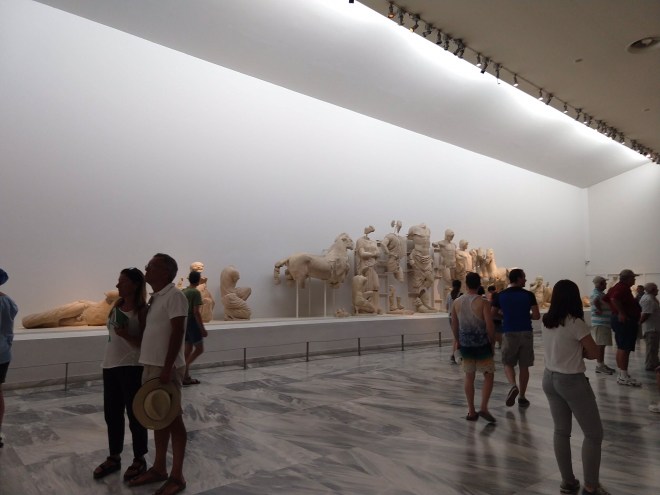
The eastern pediment depicting the Tale of Pelops, who did some sketchy things (cheating, murder) to win a chariot race in which the prize was Hippodamia, the King’s daughter. This chariot race is said to be the starting point for the tradition of chariot racing in the Olympic Games.
After the museum, we headed to the ruins.
The Olympic Games began in 776 BC and continued to occur without cancelation every four years all the way through 393 AD, when Roman Emperor Theodosios I abolished them (That’s a period of 1169 years!). During the games, a Sacred Truce between all participating city states was held tightly, which is pretty crazy considering all the war that happened between city states in Greece during that time period. When the Olympics first began, they only lasted a single day and, as more events were added, by the end they had grown to be a period of five days. Modern day Olympics that started back in 1896 have changed quite a bit since this time period, but below is where the idea of these olympics began.

All throughout the ruins you see people taking pictures as they reenact original Olympic Games – no surprise here (but it is pretty funny to watch!)! The girls above are fake wrestling 😂.
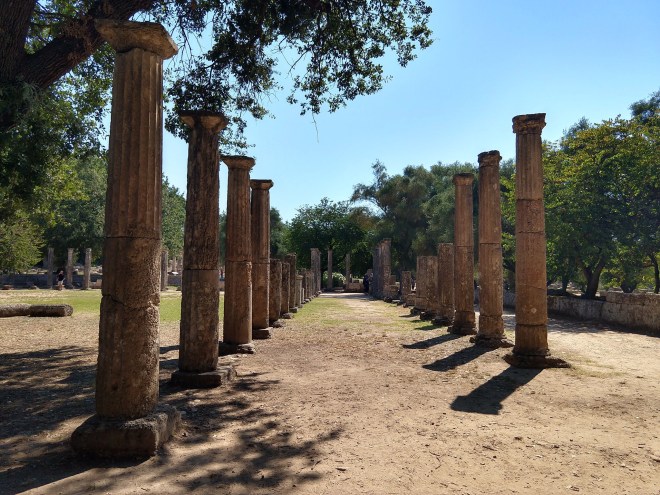
Columns
Because so much of this area of Ancient Olympia was originally temples, ruins of columns are everywhere! There are very few full walls still standing, but many columns have been recovered.
Below is the workshop of Phidias, the famous sculptor made many works for this area, including the statue of Zeus. Though this was a workshop in the 5th century BC, it later was turned into a church.

Phidias workshop

Leonidaion – built around 330 BC
The leonidaion was a very large building made to accommodate the officials of the Olympics. It had a nice courtyard that was later converted into a swimming pool by the Romans.
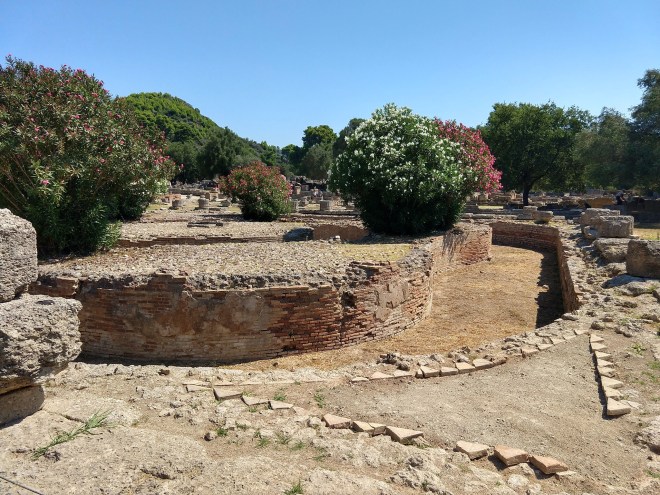
The courtyard area of the Leonidaion
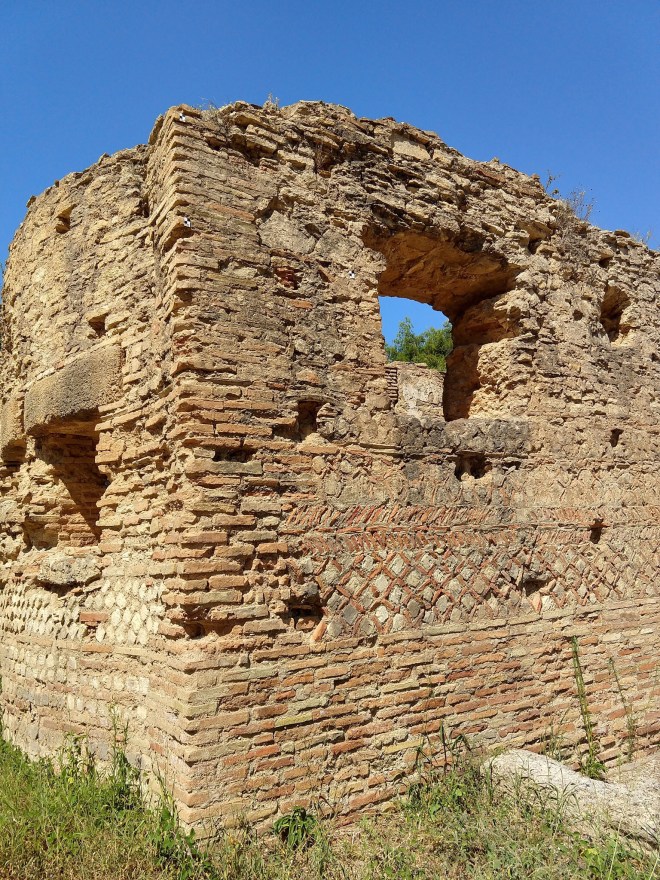
Bathhouse – I loved the brick patterns on this!

A larger view of some of the many ruins in Ancient Olympia
After wandering around a while we finally headed over to the real main attractions – first stop, the former Temple of Zeus.
Walking up to the temple, very little is intact other than the temple base and a column that has been rebuilt as an example. Even so, the ruins scattered all around are a spectacle all own their own. These former pieces of this temple are huge!
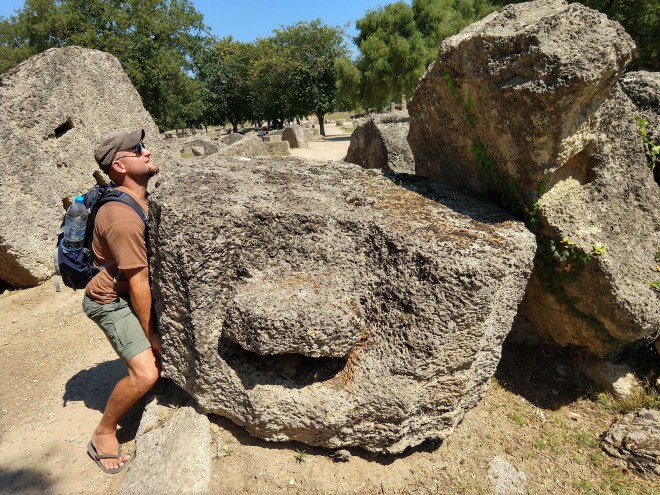 I told Kirk to stand next to the pieces to show size – he one upped me :)!
I told Kirk to stand next to the pieces to show size – he one upped me :)!
The Temple of Zeus was built between 470-452 BC and was destroyed by earthquakes in 522 and 551 AD. Even with people in the pictures, it’s hard to describe how large these leftover pieces were. The square column topper might as well have been queen sized beds, yet here they were, many of them sitting on their edge from having toppled over 1500 years ago. It’s pretty crazy to think that more time has passed since it toppled, than time had passed during the time it was standing (which was nearly a full 1000 years!)

Toppled columns with the reconstructed example in the back

The base of the Temple of Zeus with the single reconstructed column
After walking around the former Temple of Zeus, we noticed large group of people walking under an arch, so we followed, only to find ourselves standing in the original Olympic stadium.

The arch leading into the stadium
We walked out onto the field, and then up the hill for a better view.
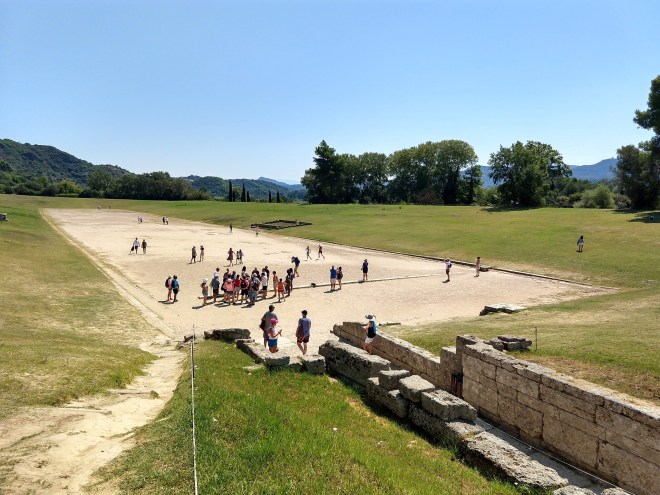
The original Olympic field where things like wrestling, boxing, and foot racing took place. We watched as many visitors entered into the stadium and lined up at the starting line, or just immediately took off running around the edge!
In the original games, players competed naked. Only men competed and only men watched (though there are stories of one or two women being in the audience, like the mother of a competitor who once snuck in 🙂 ). 45,000 people could fit in this area to watch. Though a wreath of olive leaves was the only physical prize for winning, the prestige that came from being a champion Olympian was the highest stance in society one could reach. In some ways it was like being a modern day celebrity (as far as fame goes), but imagine that much fame being attached to a game associated with the gods. Because the Olympic Games were believed to have been started by the gods, winners received this same sort of eternal fame. It was strange reading about that fame in the museum as I saw a list of winners of ancient olympics next to it. Those winners names may not have yet lasted an eternity, but they certainly have come a long way!
After visiting the stadium we walked back out to see a few final ruins. First, we stumbled upon this:

Prehistoric building 2150-2000 BC
What you see above is the oldest building we’ve seen so far, built between 2150 and 2000 BC. It’s only known as “prehistoric building” and was built on this site around 1500 years prior to the rest of the ruins on this hill. That’s insane! When the building was discovered, they also found many pots and bowls inside it.
Our next stop were the ruins of Hera’s Altar. To this day, this is the spot at which the torch for the Olympic Games is lit before it goes around the world!
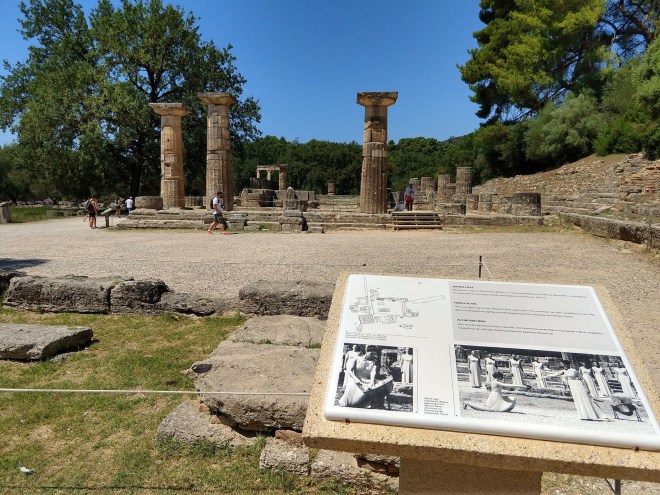
Hera’s Altar – likely those few stones to the left (sometimes it was hard to tell which sign was describing what structure 😂)

Above is a final picture of some ruins we saw. I don’t remember which ones these were, but I liked the curls at the top of the columns and the round stair base 🙂
After leaving Ancient Olympia we headed straight for Corinth. The drive along the way did not disappoint!

More mountain views

Every view was so beautiful! We pulled over on the mountain to snap a few shots and take a bathroom break.

One of Kirk’s few selfies 🙂
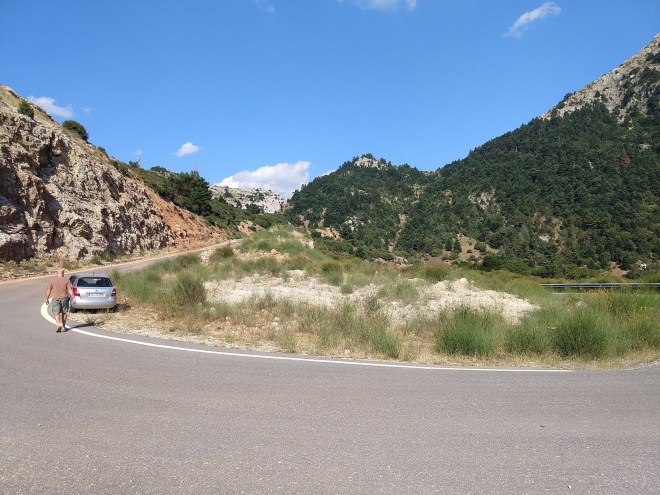
The place we pulled over for pictures.
Corinth was our final city to sleep in on the Peloponnese and was probably the place I was most excited about. We spent our days there visiting vineyards in nearby Nemea, swimming in the clear ocean waters, visiting ancient Corinth, and, on our final night, seeing an Ancient Greek play. Photos are below.
First, Nemea. We set out to Nemea for the purpose of wine tasting. We’d picked out several vineyards we were hopeful to visit, but upon arrival, we soon learned that winery tastings are open for pretty obscure hours in this area (open morning and evening, but not afternoon), and also, the signs for the vineyard were pretty hard to read (yes, it was literally Greek to us 😂). We ended up visiting random vineyards and had a lovely experience, but neither Kirk nor I have any idea where we went 😂. We even took pictures of several bottles we liked, but many of them only have Greek on them, so we can’t read it anyway! Below are pictures of two bottles we really liked that have the actual name of the vineyard on them. The third bottle is from the same vineyard as the second bottle, but will give you an idea of why the names are hard to remember!

Monolithos from Bairaktaris
Like most of the wines we tried in Nemea, Monolithos is made with agiorgitiko grapes (which are probably most comparable to the more commonly known Cabernet Sauvignons). This bottle in particular was really fruity and had never seen oak, which isn’t usually my go-to, but we were both pretty delighted when we tried it and even got a bottle. This winery had other bottles that were tasty too.
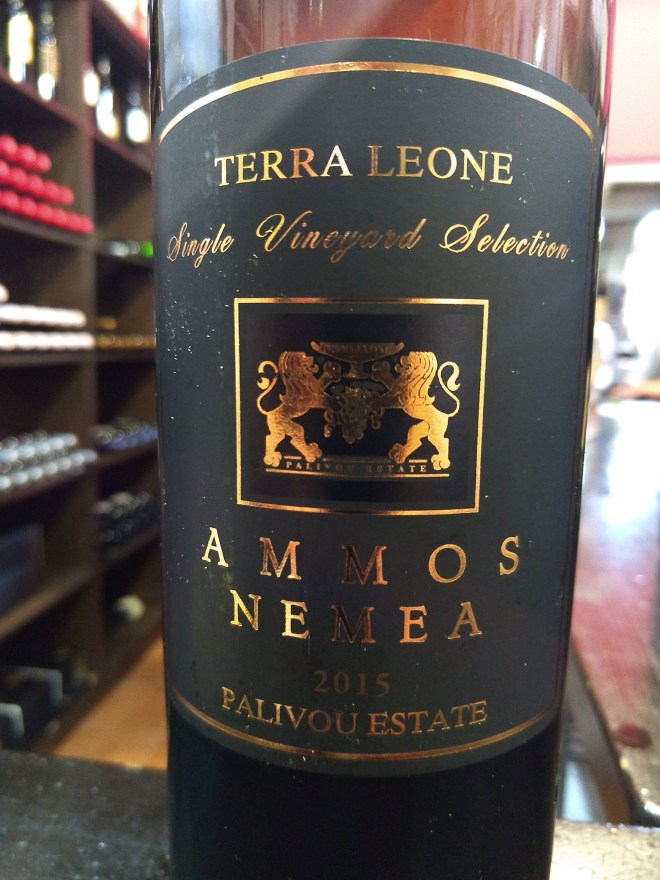
Ammos Nemea from Palivou Estate
This was Kirk’s favorite that we tried, same grape as the one above, but this one was intensely smokey and oaky – he’s regretted not getting a bottle ever since we left!

And finally, neither of us remember much about this bottle, but we must have liked it to have taken a picture of it. The real purpose of this photo being on the blog is for you to look at the Greek! This one we also tried at Palivou Estate, but we have no way of knowing that other than the background!
If you have the chance to visit vineyards in Greece, do it, but I definitely wouldn’t recommend going with a set plan 😂.
Before leaving Nemea we snapped a picture of the ruins of Ancient Nemea in the distance. The area where those white columns in the background are is a land associated with Hercules and his mighty defeat of the Nemean lion. As the story goes, Hercules killed his wife and children, and after doing so, the gods sent him to a mighty king who gave him 12 labors to accomplish to serve as penance for what he had done. The first of these labors was to slay a lion in Nemea that no man could kill. Hercules did, saving the town from the terror this lion was causing.

Ancient Nemea in the distance.
Another day we headed to the nearby beach and soak in some sun next to the gorgeous waters!
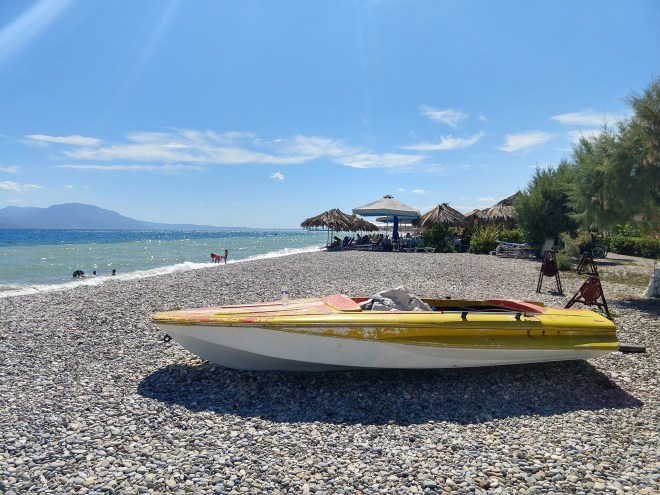
This beach was rocky, like in Kalamata, but these rocks were much smaller and easier to walk on.
We are unsure exactly what caused it, but that line of color in the water in the pictures was just as clear in real life – two different color blues right next to each other. It was different than a line caused by coral reefs as the line gradually disappeared and reappeared down the shoreline later in the day. It was strange and beautiful.

Two toned water

A straight on view of the line in the water
Our final day in Corinth we headed to ancient Corinth, the city that housed the church to which 1st and 2nd Corinthians are written. Paul himself not only lived in this city, but was put on trial here. It’s the city in which he worked with Priscilla and Aquila as a tent maker (Acts 18:1-3), meaning he likely sold his tents somewhere in the marketplace that we eventually found ourselves standing in. Before I get too far into that though, we’ll back track a bit and take a look at the Corinthian museum.
Before walking around the Corinthian ruins, we visited the museum next door. There, we learned a little about life in Corinth and saw some of the oldest stuff we’ve seen this trip. Perhaps the things pictured below aren’t the best description of everything you can see in this museum, but they are certainly things that stood out to me 🙂
Below, everything in this case dates somewhere between 6500 BC and 3250 BC. Numbers 30 and 31 (the cup and bowl in the back that have been reconstructed) are the oldest, dating somewhere between 6500 BC and 5750 BC! That’s crazy!
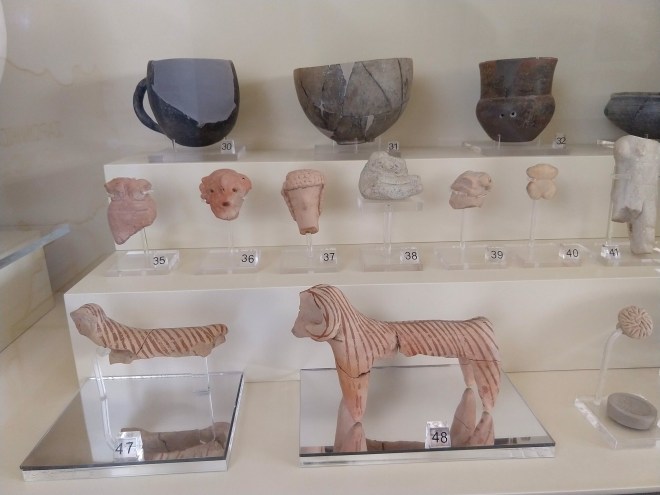
Really old stuff
At this museum I also finally took a picture of the Greek vase art that reminds me of the Disney movie “Hercules” every time I see it 😂 ( 🎶 “Bless my soul, Herc was on a roll. Person of the week in every Greek opinion poll…” Anybody with me?) Vases and pitchers decorated similar to the one below fill the museums.
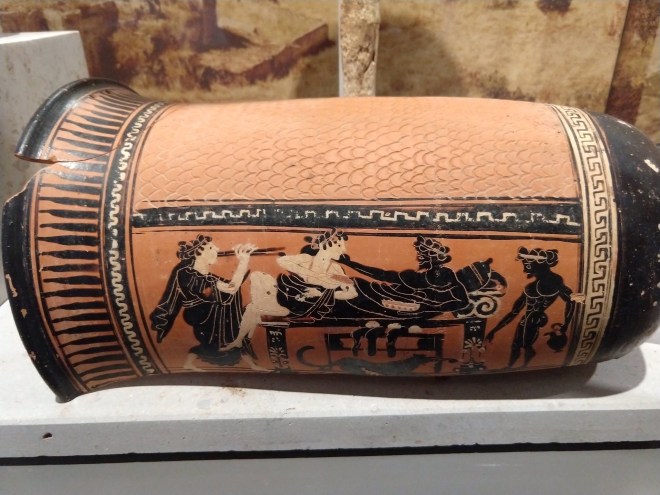
Greek art
Below is a picture of a pitcher with salted fish scales that was found while excavating Corinth (those fish scales are 2500 years old! Salt must really be a good preservative!). We read excavators also found a sign that labeled a particular place in the market as the “Meat shop.” We never found the sign, but it was interesting to consider that this is possibly the meat shop that Paul had in mind when he says “Eat anything sold in the meat market without raising questions of conscience” in 1 Corinthians 10:25. Interesting, eh?
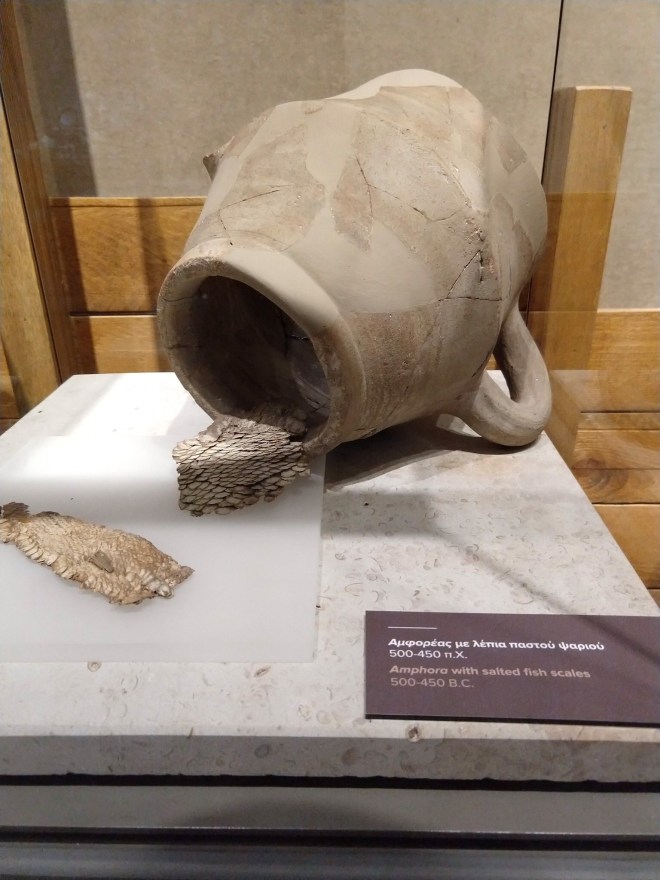
Salted fish scales from 500-450 BC
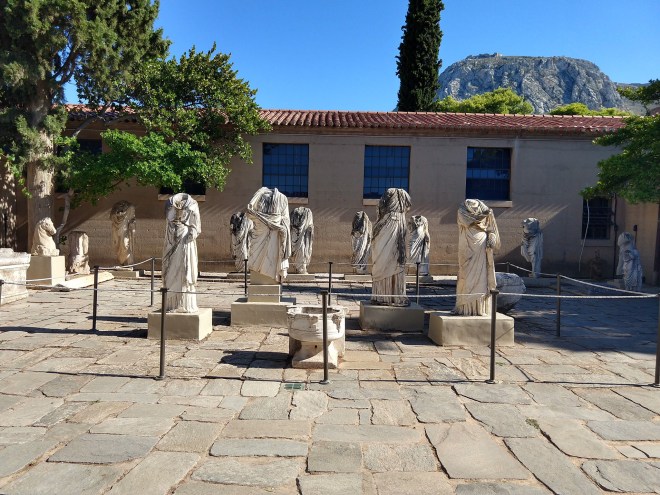
Many headless statues they’ve found in this area.
My final picture from the museum is of beauty products that were used by women in Corinth. From what we read, Corinthian men focused on business and politicking, the slaves and second class citizens kept all of the everyday work running (housework, fields, etc), and the women focused on the children and beauty. I had no idea that women had so many beauty products available then, but in the case below are tweezers, boxes for their powder, vases for their perfumes, and a description of how they used charcoal as eyeliner. Who knew?

Corinthian women’s beauty products
Leaving the museum, we entered the ruins. Right at the front the excavation site is the infamous Temple of Apollo.
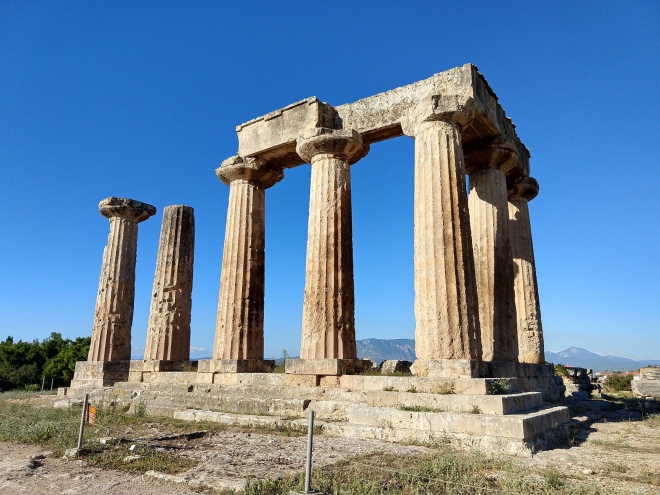
Temple of Apollo built in 6th century BC
Little remains of this once grand structure, but the Temple of Apollo is still the centerpiece of the ruins in Corinth. Not only was this structure here when Paul was in the city, but it had already been standing for around 600 years by the time Paul was alive to lay eyes on it. This was an ancient structure to Paul – it’s extra ancient to us!

A Panorama of Ancient Corinth, Temple of Apollo to the left and mountain in the back ground.
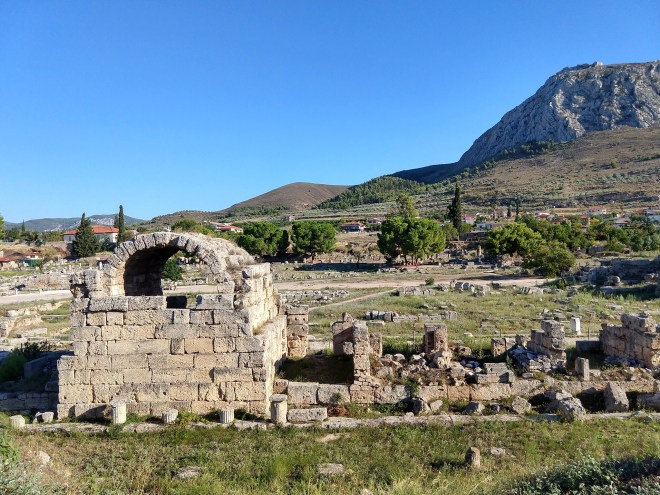
Looking out over Corinth from the road beside the Temple of Apollo

View of the Temple of Apollo from the other side

Panorama of the city from another side
As we walked around the ruins, we soon came to a building labeled as the Northwest Shops. We don’t know if this could have been the building the housed Paul and his tents, or the meat market that he mentions, but it was fun to consider!

Northwest Shops of Corinth

Me, checking out the archway of the Northwest shops. That’s pretty tall!
After checking out the shops, we noticed that nearby was the Bema, one of the main attractions we’d come to see. During Paul’s time in Corinth, he was met with much opposition from the Jewish community. He focused his teaching on the Gentiles, but still ended up in court because the Jews were claiming his teachings were illegal. On this bema is where Paul sat while awaiting judgement from Proconsul Gallio, who ultimately decided that this dispute was not for the courts to decide, but rather, it was a mere religious dispute. Paul was allowed to go on teaching (story in Acts 18:12-17).
It’s also thought that Paul might have preached from the bema too.
Much later, the bema was made into a basilica, and what you see below is what is left of it all today.

Bema on which Paul was on trial
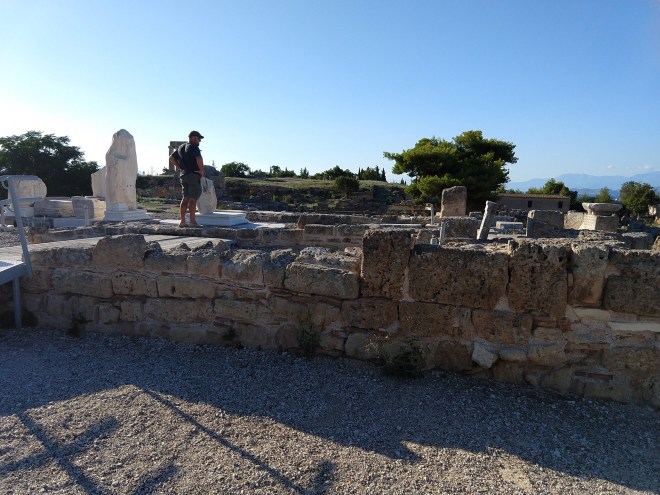
The bema from the other side, Kirk on top.

On top of the bema, pieces of the church built on this site resting on top. It’s pretty crazy that this Paul I’ve heard about my whole life was once right here!
After seeing the bema, we walked around a little longer to see if we found anything else that interested us. We found another marketplace and some baths that were in good shape before we headed back out to the car.
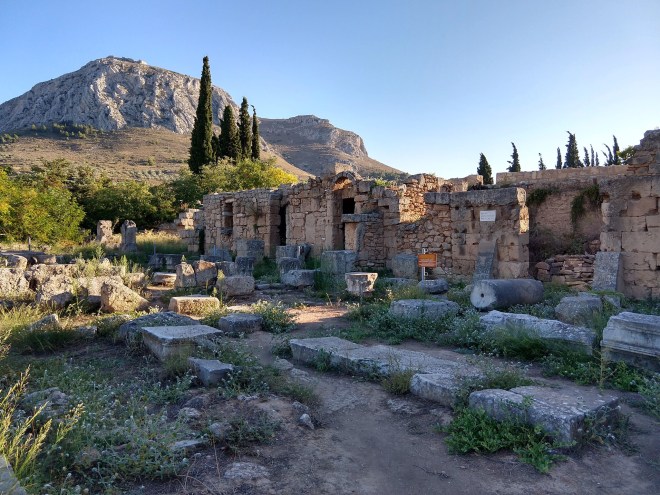
The second marketplace

Kirk wandering around the baths.
Our final event to attend near Corinth was an Ancient Greek play. A month prior to visiting Greece we learned that the Festival of Dionysus would be going on while we were in the country. Though the Festival of Dionysus is an ancient festival, it’s been revived as a modern event that happens every year in which Ancient Greek plays are put on in Ancient Greek theaters. How cool is that? Since theater originated in Greece, we knew we had to go. We bought tickets ahead of time (nosebleed section, right under $10 each!) and headed to the Theater of Epidavros to watch a play called “The Frogs.” This play in particular was written by Aristophanes and was performed at a Festival of Dionysus in Athens in 405 BC. It won first place.
The theater in which we went to see the play was pretty impressive. The Theater of Epidavros is an enormous theater that began being built in 4th century BC and was added on to in 2nd century BC. It has a capacity of 14,000 people.
Though long ago this play would have been done in this theater without amplifiers, we were thankful for the mic system and screen that translated the Greek they were speaking into English :).
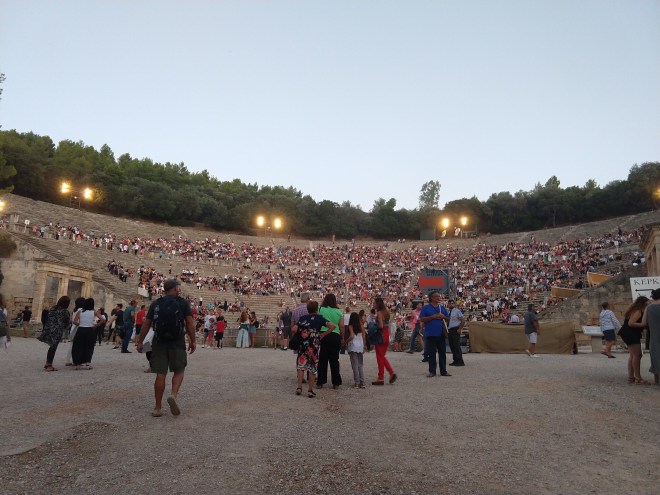
Walking up to the theater
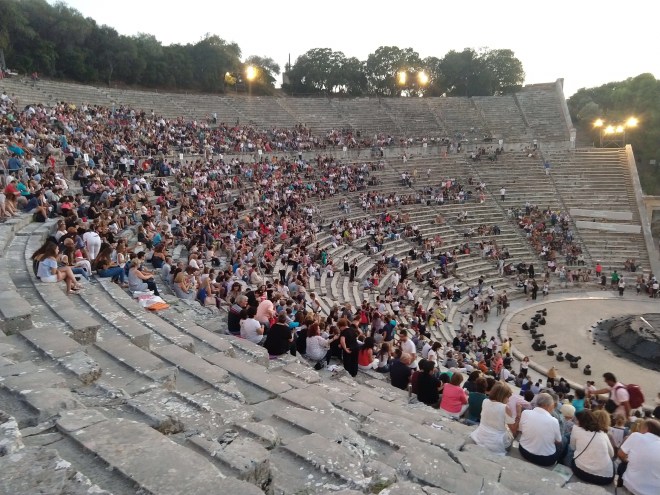
Getting to our “nosebleed” seats, which were actually not too bad! Many of the stones seemed to be left in the condition in which they were found (though I’m sure many had to be moved back in place, even if they weren’t repaired). How amazing is this place?

The sun setting over the theater, just before showtime.
Unfortunately, cameras weren’t allowed once the show started, but it was certainly an interesting experience! Once the sun had finished setting, they dimmed the lights and the show began. We found ourselves sitting in an old stone theater, watching an ancient play under a canopy of stars. It was beautiful.
The play itself was a comedy and was filled with sexual innuendo, political jokes, lots of exaggerations, and humor about the Greek gods. It was fascinating to see what types of humor were in plays from so long ago, and it was also cool to see how they integrated some more modern aspects/jokes into the play. Perhaps the biggest difference in this play and more modern ones is the way that they seemed to stretch out the humor. The author of the play hammered hard on certain jokes, making them last longer than most in modern times would think was funny. (Though I could easily see how these jokes would have been more entertaining for longer, when theater was first being developed – opposed to modern times when we watch ever changing dialogue and screens on the tv). In some ways, it made for a very long night, and after reading a screen in the dark for three hours, Kirk and I snuck out before the play was finished 😬. It’s strange how much I enjoyed the experience while also being so very ready to go by the time we did. I’d absolutely suggest it to anyone who finds themselves in Greece for this festival, but go in knowing you are in for a potentially long night!
As we left Corinth the next day to bring the rental car back to Athens, we stopped by the Corinth Canal to take in the view. This famous canal was conceptualized way back in 1st century AD (maybe even earlier), but wasn’t able to be completed until 1893. Before there were enough resources to blast out this canal as a sailing shortcut between the Gulf of Corinth and and the Aegean Sea, boats used to be pulled over land on wooden logs the full 6.4 kilometer length to avoid the rough waters they’d have to face by going around. The waters here are crystal clear and at any given point in the day the colors below shine deep blue to aqua. It’s quite beautiful and a very long way down!

The Corinth Canal
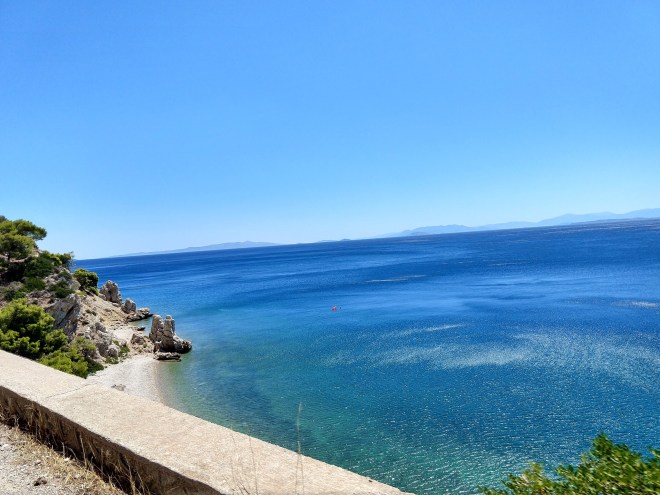
Our final views of the ocean on our road trip!
After returning the car we caught a bus back out to Patras (on the Peloponnese) to catch a ferry to Italy. Below are a few pictures of our final couple of days in Greece.
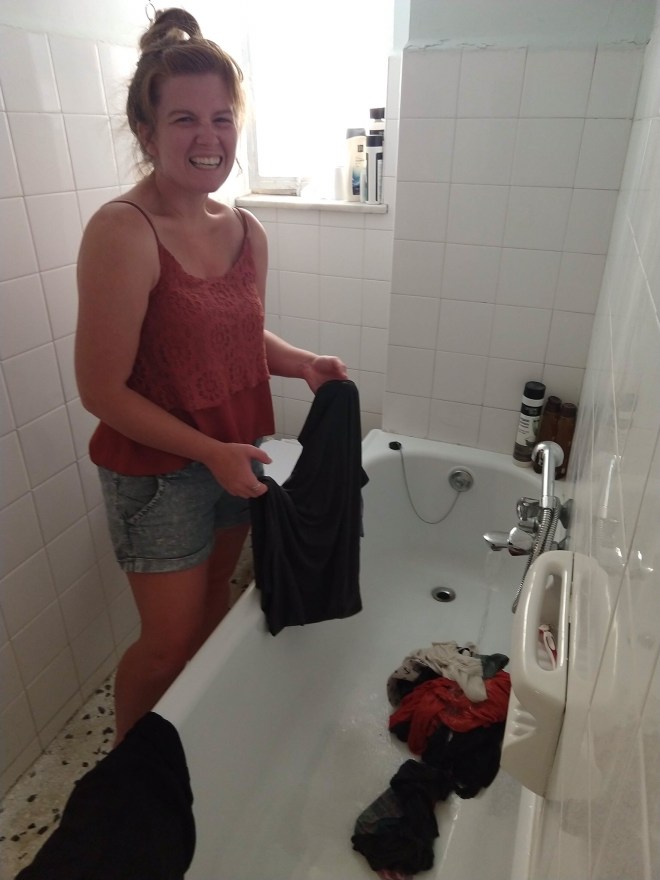
Laundry
Kirk thought it might be a good idea to show some of the less fun parts of traveling on the blog – I agree. Laundry is one of those things! We’ve done laundry in sinks and showers so many times! We were thankful to have a tub at this place, though we certainly prefer washers :)!

Hanging laundry – hang ’em where you can!
As we explored Patras we found areas that were covered with anarchist graffiti and posters. We found this to be pretty common throughout Greece. It seems to be a common response to the austerity measures put in place since the Greek financial crisis. 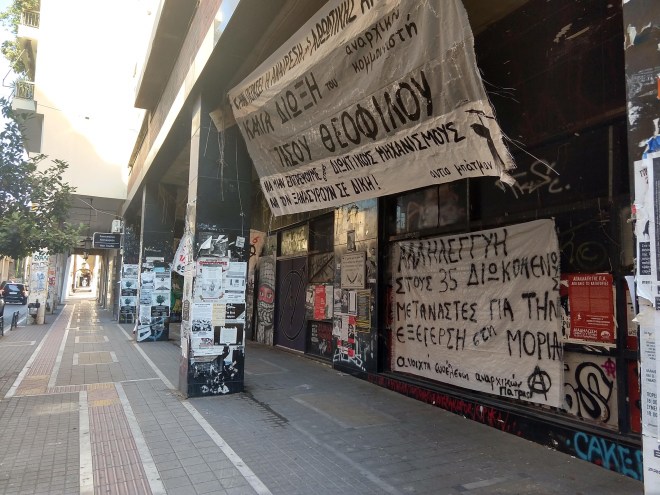
Anarchist posters
Another day we walked over the St. Andrews Cathedral, a church built where Andrew is believed to be buried.
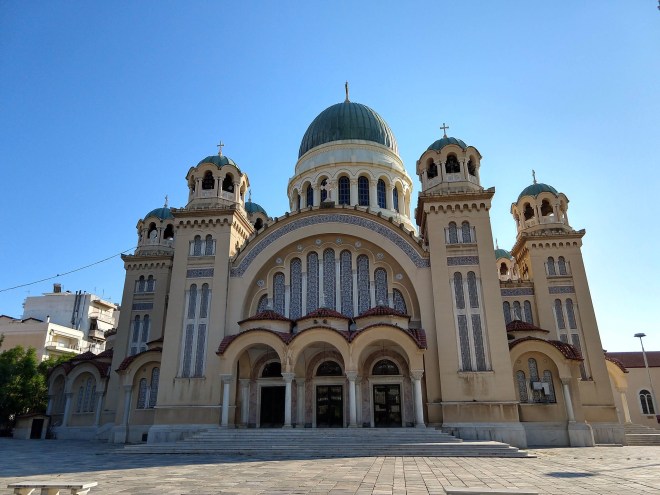
St. Andrews Cathedral
Next, a snippet of yummy Greek food

Moussaka – an eggplant or potato based dish similar to a lasagna.
Another dish we wanted to try but didn’t get to was Pastitsio – a baked pasta dish made with lamb and bechamel sauce. We might try to make it ourselves when we get home 🙂
Our final day in Greece we packed up and headed to the ferry dock for our overnight boat ride to Brindisi, Italy. We’d booked the cheapest overnight ferry tickets possible – ones that were supposed to have us sleeping on the hard metal boat deck under the stars.
As nice (and somewhat uncomfortable) as it sounded, we ended up getting pretty lucky. Upon arrival the attendant checking us in said, “We are not too full, so you can also sit in the poor man’s seat section.”
Thinking we must have heard her wrong Kirk said, “I’m sorry, what did you say?”
“The poor man’s section, it’s up.”
“Okay, thank you.”
We walked away wondering what they must call our section if the next step us for us is “the poor man’s section” 😂.
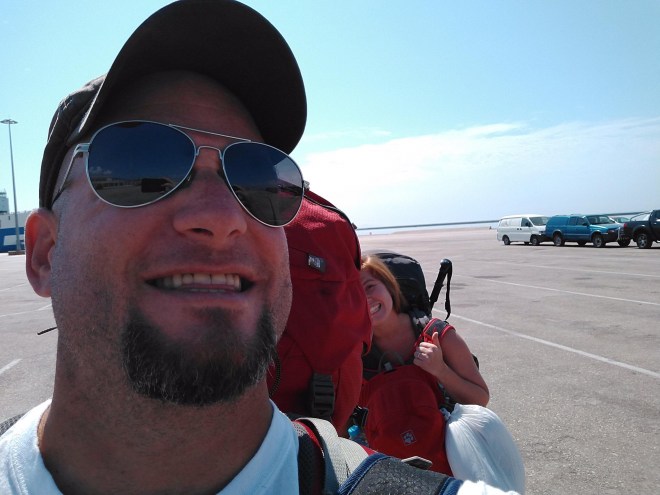
Walking through the huge ferry parking lot with all our things

“The poor man’s section”, of which there were six of us sleeping. We all spread out, taking whole rows to ourselves. We actually slept pretty well.
Lastly, a photo google stylized that Kirk took on the boat. Those colors are definitely not real life, but we liked it 🙂

Next blog begins our time in Italy!